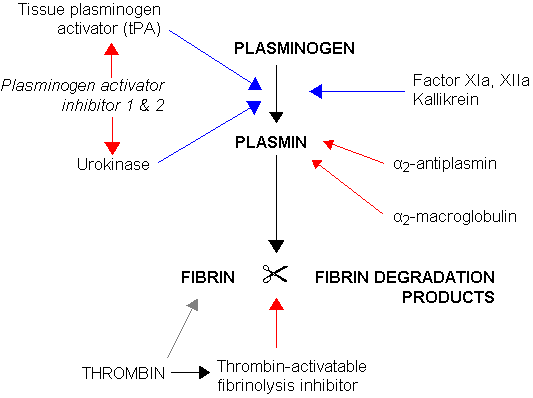alpha-2-Macroglobulin
| Identifiers | |
|---|---|
| Symbol | A2M |
| Entrez | 2 |
| HUGO | 7 |
| OMIM | 103950 |
| RefSeq | NM_000014 |
| UniProt | P01023 |
| Other data | |
| Locus | Chr. 12 p13.31 |
alpha-2-Macroglobulin, also known as α2-macroglobulin and abbreviated as α2M and A2M, is a large plasma protein found in the blood. It is produced by the liver, and is a major component of the alpha-2 band in protein electrophoresis.
Structure
Alpha-2-macroglobulin is compose of four identical subunits bound together by -S-S- bonds.
Function
Alpha-2-macroglobulin is able to inactivate an enormous variety of proteinases (including serine-, cysteine-, aspartic- and metalloproteinases).
Alpha-2-macroglobulin has in its structure a 35 aminoacid "bait" region. Proteinases binding and cleaving the bait region become bound to α2M. The proteinase-α2M complex is recognised by macrophage receptors and cleared from the system.
It functions as an inhibitor of coagulation by inhibiting thrombin.[1]
It functions as an inhibitor of fibrinolysis by inhibiting plasmin and kallikrein

Disease
Alpha-2-macroglobulin levels are increased in nephrotic syndrome, a condition wherein the kidneys start to leak out some of the smaller blood proteins. Because of its size, α2-macroglobulin is retained in the bloodstream. Increased production of all proteins means α2-macroglobulin concentration increases. This increase has little adverse effect on the health, but is used as a diagnostic clue. Longstanding chronic renal failure can lead to amyloid by alpha-2-macroglobulin (see main article: amyloid).
A common variant (29.5%) (polymorphism) of α2-macroglobulin leads to increased risk of Alzheimer's disease,[2][3] although the mechanism is unknown.
α-2-macroglobulin binds to and removes the active forms of the gelatinase (MMP-2 and MMP-9) from the circulation via scavenger receptors on the phagocytes.
References
- ↑ Boer JP, Creasey AA, Chang A, Abbink JJ, et al. (1993) "Alpha-2-macroglobulin functions as an inhibitor of fibrinolytic, clotting, and neutrophilic proteinases in sepsis: studies using a baboon model." Infect Immun. '61'(12): 5035–5043.
- ↑ Blacker D, Wilcox MA, Laird NM; et al. (1998). "Alpha-2-macroglobulin is genetically associated with Alzheimer disease". Nat Genet. 19 (4): 357–60. PMID 9697696.
- ↑ Kovacs DM (2000). "alpha2-macroglobulin in late-onset Alzheimer's disease". Exp Gerontol. 35 (4): 473–9. doi:10.1016/S0531-5565(00)00113-3. PMID 10959035.
4. G.R. Andersen, T.J. Koch, K. Dolmer, L. Sottrup-Jensen and J. Nyborg, Low resolution X-ray structure of human methylamine-treated alpha 2-macroglobulin, J. Biol. Chem. 270 (1995), pp. 25133–25141.
External links
- alpha+2-Macroglobulin at the US National Library of Medicine Medical Subject Headings (MeSH)